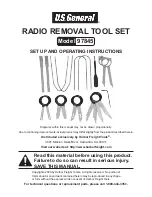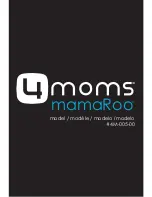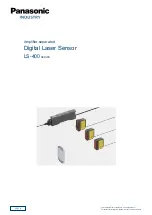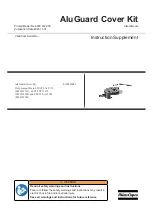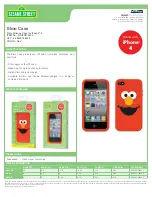
FIGURE 3. FEATURES OF THE PHOTO/CO DETECTOR
Base Alignment Notch
CO Test Point
Magnet Test Point
LEDs
C2046-00
FIGURE 4. CLEANING THE PHOTO/CO DETECTOR
Cover
Removal
Tabs
Sensor Cover
Sensing Chamber
Cover and Screen
Sensing
Chamber
}
C2047-00
CAUTION
Dust covers provide limited protection against airborne dust particles during
shipping. Dust covers must be removed before the sensors can sense smoke.
Remove sensors prior to heavy remodeling or construction.
TAMPER RESISTANCE
Model FIK-PC351 includes a tamper-resistant capability that prevents removal
from the base without the use of a tool. Refer to the base manual for details on
making use of this capability.
TESTING
Before testing, notify the proper authorities that the system is undergoing
maintenance, and will temporarily be out of service. Disable the system to
prevent unwanted alarms.
All sensors must be tested after installation and periodically thereafter. Test-
ing methods must satisfy the Authority Having Jurisdiction (AHJ). Sensors
offer maximum performance when tested and maintained in compliance with
NFPA 72. Sensitivity readings are available through the FACP. Refer to the
manufac turer’s published instructions for proper use.
The sensor can be tested in the following ways:
A. Functional: Magnet Test (P/N M02-04-01 or M02-09-00)
This sensor can be functionally tested with a test magnet. The test magnet
electronically simulates smoke in the sensing chamber, testing the sensor
electronics and connections to the control panel.
a. Hold the test magnet in the magnet test area as shown in Figure 3.
b. The sensor should alarm the panel.
Two LEDs on the sensor are controlled by the panel to indicate sensor
status. Coded signals, transmitted from the panel, can cause the LEDs to
blink, latch on, or latch off. Refer to the control panel technical documen-
tation for sensor LED status operation and expected delay to alarm.
NOTE: The magnet test initiates an approximately 10 minute period when
the detector's signal processing software routines are not active.
B. Smoke Entry
Canned aerosol simulated smoke (canned smoke agent) may be used for
smoke entry testing of the smoke detector.
The multi-criteria photoelectric and CO detector uses algorithms to pro-
cess signals received from multiple sensors to determine alarm conditions
and reduce false alarms. Therefore, a single burst of canned smoke will
not immediately place the detector into an alarm condition because the
detector algorithms correctly determine a burst of canned smoke is not
fire. In order to perform functional testing of the photoelectric sensor, the
device must be placed into test mode. Test mode allows the detector to
isolate the individual sensors for testing. The device can be placed into
test mode through either of the following methods.
a. Put the device into test mode by holding a test magnet in the magnet
test area as shown in Figure 3 for 6-12 seconds.
NOTE: If the magnet is held in place for too long the fire alarm test func-
tion will be triggered. (See Magnet Test, above.) Reset the panel and pro-
ceed with testing the smoke entry portion of the device.
b. Perform smoke entry testing immediately following the magnet test. The
magnet test initiates an approximately 10 minute period when the detec-
tor’s signal processing software routines are not active.
Once in test mode, test the smoke detector using one of the tested and ap-
proved aerosol smoke products. Refer to the manufacturer’s published instruc-
tions for proper use of the canned smoke agent. When used properly, the
canned smoke agent will cause the smoke detector to go into alarm.
Tested and approved aerosol smoke products include:
Manufacturer
Model
HSI Fire and Safety
25S, 30S (PURCHECK)
SDi
SMOKE CENTURION , SOLO A10,
SMOKESABRE, TRUTEST, SOLO 365
No Climb
TESTIFIRE 2000
CAUTION
Canned aerosol simulated smoke (canned smoke agent) formulas will vary
by manufacturer. Misuse or overuse of these products may have long term
adverse effects on the smoke detector. Consult the canned smoke agent manu-
facturer’s published instructions for any further warnings or caution statements.
C. Multi-Criteria Testing
Testifire® by SDi provides testing of the photoelectric and CO sensors. Consult
the manufacturer’s published instructions for complete usage instructions.
A sensor that fails any of these tests may need to be cleaned as described
under CLEANING, and retested. When testing is complete, restore the system
to normal operation and notify the proper authorities that the system is back
in operation.
D. Functional Gas Test
NOTE: Check with local codes and the AHJ to determine whether or not a
functional gas test is desired for an installation.
A canned CO testing agent may be used to verify the detector’s ability to
sense CO. Carbon Monoxide alarm thresholds are designed around CO
concentrations over time, as defined in UL standard 2034. Therefore, a
single burst of CO test agent will not immediately place the detector into
an alarm condition. In order to perform functional testing of the CO sen-
sor, the device must be placed into test mode. Test mode eliminates the
time and concentration requirements needed for alarm and allows the CO
sensor to be tested. The device can be placed into test mode through either
of the following methods.
a. Put the device into test mode by holding a test magnet in the magnet
test area as shown in Figure 3 for 6-12 seconds.
NOTE: If the magnet is held in place for too long the fire alarm test func-
tion will be triggered. Reset the panel and proceed with testing the CO
portion of the device.
b. Perform functional gas entry testing immediately following the magnet
test. The magnet test initiates an approximately 10 minute period when
the detector's signal processing software routines are not active.
Once in test mode, test the CO sensor using a tested and approved canned
CO testing agent. A tested and approved canned CO testing agent is Solo
detector testers model C6 CO Detector Tester available from SDi. Complete
the CO sensor testing as follows:
Spray a UL approved CO agent into the top of the detector near the CO
sensor opening for at least 1 second. CO sensor opening is indicated by
a triangle on the sensor cover. (See Figure 3.) Use the applicator straw
included with the CO agent to more efficiently direct the CO into the detec-
tion cell during testing.
The detector will go into alarm if gas entry is successful. It may take up
to 1 minute for the device to alarm. Once the detector is in alarm allow
5 minutes for the CO to clear and exit the detector.
2
I56-6638-000
1/15/2021








